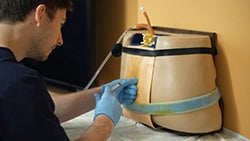The Pitt Nurse Anesthesia Program is a national leader in simulation education, developing a course on Anesthesia Crisis Management for CRNAs as early as 1994. The simulation lab in the Pitt School of Nursing is a new, state-of-the-art facility designed to offer a range of simulation experiences from ‘part-task’ training to 'full context' simulation activities. The educational approach is to have learning occur in an environment that is close enough to the clinical environment to promote effective learning with translation of knowledge and skills to practice. 
The School of Nursing simulation labs contain anesthesia gas machines; anesthesia carts; emergency carts; a malignant hyperthermia (MH) cart; OR supplies; critical care supplies; gas supply; vacuum; intercom; alarm systems; and a line of Laerdal Mannequins including SimMan®, SimMom®, SimBaby®, SimNewbie®, and SimEssential®. The labs have sophisticated, streaming audiovisual capability with multiple active cameras, audio and video mixers, monitors, and digital recorders.
Additional simulation experiences take place at the 16,000 square-foot Peter M. Winter Institute for Simulation Education and Research (WISER). WISER is a world class inter-professional simulation training and research facility focused on improving education and patient safety through effective healthcare provider education. Students from the Schools of Medicine, Nursing, Dental Medicine, Pharmacy and other Health Sciences schools are educated at WISER. Further, WISER supports practicing professionals in the 40 UPMC hospitals that have more than 89,000 employees. The expertise of the staff and faculty of WISER helps to optimize the educational experiences for students in the Nurse Anesthesia Program.
Simulation educational activities currently offered by the Pitt Nurse Anesthesia Program include:
First Year
- Gowning and Gloving
- IV insertion
- Arterial line insertion
- Central venous catheter insertion
- Anesthesia gas machine checkout
- Pre-operative evaluation
- Positioning for surgery
- Airway workshop
- Spinal anesthesia insertion
- Epidural anesthesia insertion
- Sterile field preparation
- Mock induction of anesthesia
Second and Third Years
- Physical Diagnosis for Anesthesia Providers- use of SPs in an OSCE setting
- Problem-based simulation (cardiac, respiratory, GI, neuro)
- Pediatric simulation
- Double-lumen endotracheal tube insertion
- Fiberoptic bronchoscopy simulation
- Anesthesia crisis leadership training
- Mentored simulation teaching experiences
- Difficult airway simulation
- Regional anesthesia workshop (spinal, epidural, peripheral nerve block, cadaver exploration, ultrasound use)
- ACLS/PALS/BLS Bundle using Simulation (optional)
